International Employment Relations: A Three-Country Comparison
VerifiedAdded on 2020/05/08
|8
|1632
|170
Report
AI Summary
This report provides a comparative analysis of international employment relations, focusing on the UK, Japan, and the Philippines. It examines the remuneration systems, human resource management practices, and employment relations in each country. In Japan, the report highlights the seniority-based remuneration system and the importance of employee loyalty, contrasting this with the wage inequalities and collective bargaining in the UK. The Philippines, characterized by merit-based compensation and outsourcing of HR functions, is also discussed. The report explores the unique aspects of each country's approach, offering insights into the diverse strategies and challenges in managing international employment relations. It also covers the impact of globalization and localization on HR practices.
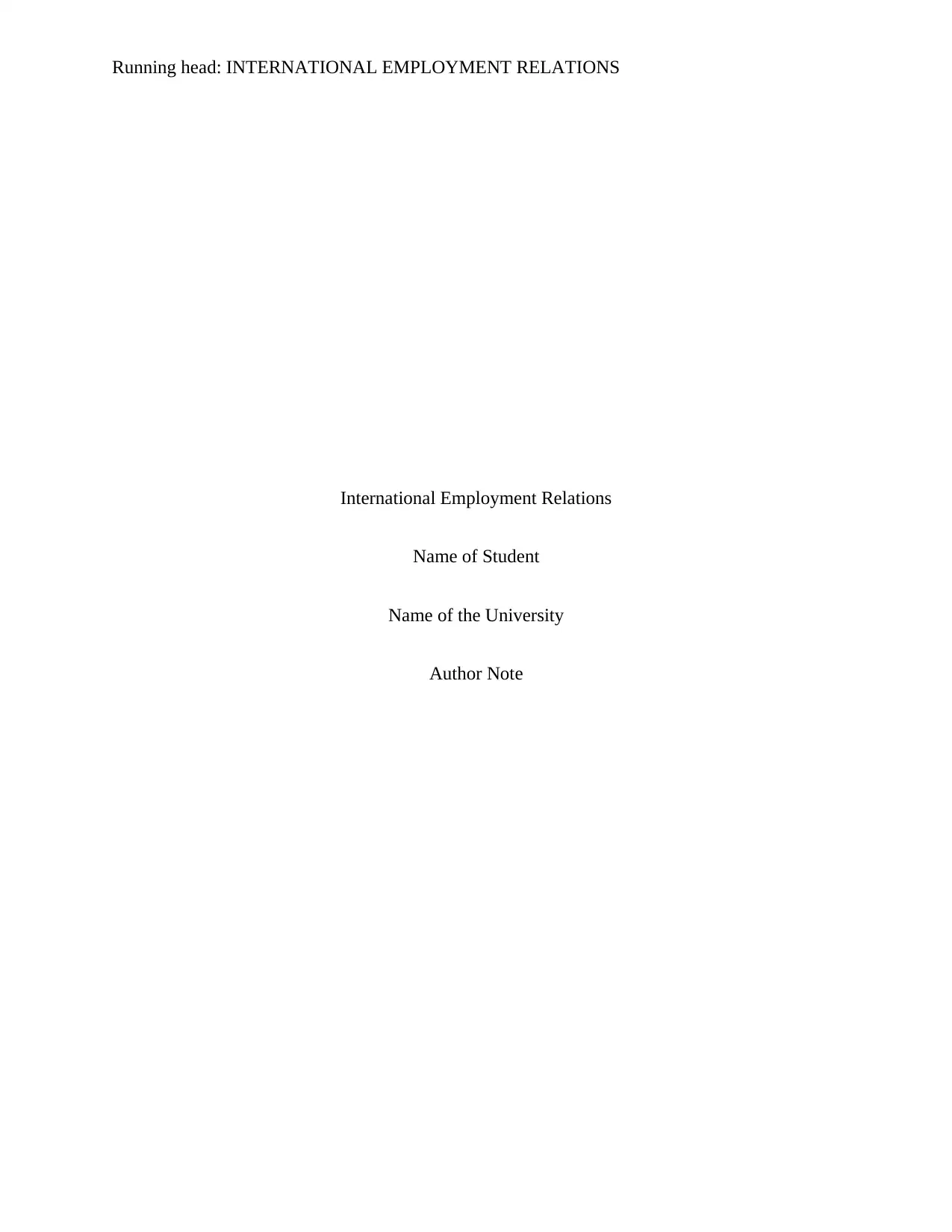
Running head: INTERNATIONAL EMPLOYMENT RELATIONS
International Employment Relations
Name of Student
Name of the University
Author Note
International Employment Relations
Name of Student
Name of the University
Author Note
Paraphrase This Document
Need a fresh take? Get an instant paraphrase of this document with our AI Paraphraser
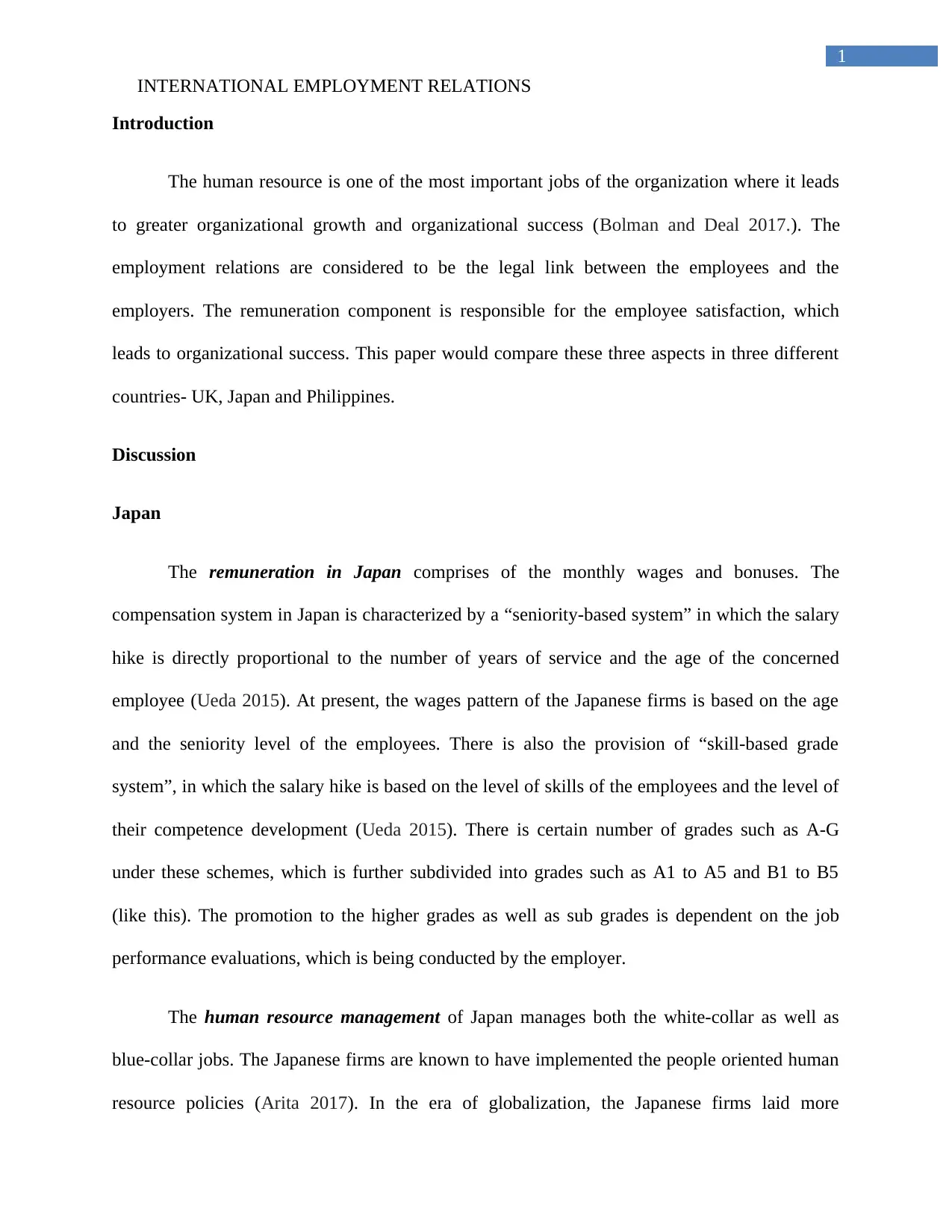
1
INTERNATIONAL EMPLOYMENT RELATIONS
Introduction
The human resource is one of the most important jobs of the organization where it leads
to greater organizational growth and organizational success (Bolman and Deal 2017.). The
employment relations are considered to be the legal link between the employees and the
employers. The remuneration component is responsible for the employee satisfaction, which
leads to organizational success. This paper would compare these three aspects in three different
countries- UK, Japan and Philippines.
Discussion
Japan
The remuneration in Japan comprises of the monthly wages and bonuses. The
compensation system in Japan is characterized by a “seniority-based system” in which the salary
hike is directly proportional to the number of years of service and the age of the concerned
employee (Ueda 2015). At present, the wages pattern of the Japanese firms is based on the age
and the seniority level of the employees. There is also the provision of “skill-based grade
system”, in which the salary hike is based on the level of skills of the employees and the level of
their competence development (Ueda 2015). There is certain number of grades such as A-G
under these schemes, which is further subdivided into grades such as A1 to A5 and B1 to B5
(like this). The promotion to the higher grades as well as sub grades is dependent on the job
performance evaluations, which is being conducted by the employer.
The human resource management of Japan manages both the white-collar as well as
blue-collar jobs. The Japanese firms are known to have implemented the people oriented human
resource policies (Arita 2017). In the era of globalization, the Japanese firms laid more
INTERNATIONAL EMPLOYMENT RELATIONS
Introduction
The human resource is one of the most important jobs of the organization where it leads
to greater organizational growth and organizational success (Bolman and Deal 2017.). The
employment relations are considered to be the legal link between the employees and the
employers. The remuneration component is responsible for the employee satisfaction, which
leads to organizational success. This paper would compare these three aspects in three different
countries- UK, Japan and Philippines.
Discussion
Japan
The remuneration in Japan comprises of the monthly wages and bonuses. The
compensation system in Japan is characterized by a “seniority-based system” in which the salary
hike is directly proportional to the number of years of service and the age of the concerned
employee (Ueda 2015). At present, the wages pattern of the Japanese firms is based on the age
and the seniority level of the employees. There is also the provision of “skill-based grade
system”, in which the salary hike is based on the level of skills of the employees and the level of
their competence development (Ueda 2015). There is certain number of grades such as A-G
under these schemes, which is further subdivided into grades such as A1 to A5 and B1 to B5
(like this). The promotion to the higher grades as well as sub grades is dependent on the job
performance evaluations, which is being conducted by the employer.
The human resource management of Japan manages both the white-collar as well as
blue-collar jobs. The Japanese firms are known to have implemented the people oriented human
resource policies (Arita 2017). In the era of globalization, the Japanese firms laid more
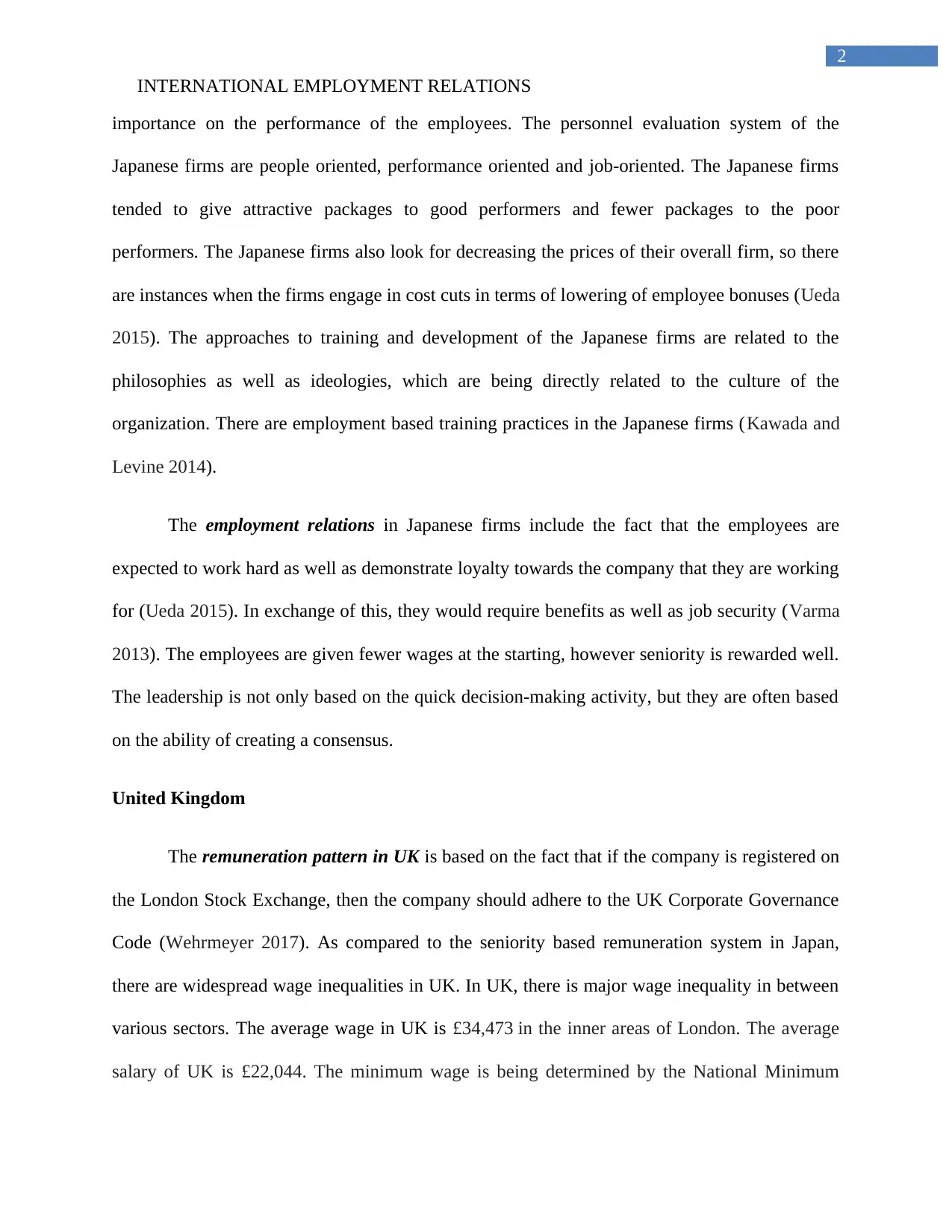
2
INTERNATIONAL EMPLOYMENT RELATIONS
importance on the performance of the employees. The personnel evaluation system of the
Japanese firms are people oriented, performance oriented and job-oriented. The Japanese firms
tended to give attractive packages to good performers and fewer packages to the poor
performers. The Japanese firms also look for decreasing the prices of their overall firm, so there
are instances when the firms engage in cost cuts in terms of lowering of employee bonuses (Ueda
2015). The approaches to training and development of the Japanese firms are related to the
philosophies as well as ideologies, which are being directly related to the culture of the
organization. There are employment based training practices in the Japanese firms (Kawada and
Levine 2014).
The employment relations in Japanese firms include the fact that the employees are
expected to work hard as well as demonstrate loyalty towards the company that they are working
for (Ueda 2015). In exchange of this, they would require benefits as well as job security (Varma
2013). The employees are given fewer wages at the starting, however seniority is rewarded well.
The leadership is not only based on the quick decision-making activity, but they are often based
on the ability of creating a consensus.
United Kingdom
The remuneration pattern in UK is based on the fact that if the company is registered on
the London Stock Exchange, then the company should adhere to the UK Corporate Governance
Code (Wehrmeyer 2017). As compared to the seniority based remuneration system in Japan,
there are widespread wage inequalities in UK. In UK, there is major wage inequality in between
various sectors. The average wage in UK is £34,473 in the inner areas of London. The average
salary of UK is £22,044. The minimum wage is being determined by the National Minimum
INTERNATIONAL EMPLOYMENT RELATIONS
importance on the performance of the employees. The personnel evaluation system of the
Japanese firms are people oriented, performance oriented and job-oriented. The Japanese firms
tended to give attractive packages to good performers and fewer packages to the poor
performers. The Japanese firms also look for decreasing the prices of their overall firm, so there
are instances when the firms engage in cost cuts in terms of lowering of employee bonuses (Ueda
2015). The approaches to training and development of the Japanese firms are related to the
philosophies as well as ideologies, which are being directly related to the culture of the
organization. There are employment based training practices in the Japanese firms (Kawada and
Levine 2014).
The employment relations in Japanese firms include the fact that the employees are
expected to work hard as well as demonstrate loyalty towards the company that they are working
for (Ueda 2015). In exchange of this, they would require benefits as well as job security (Varma
2013). The employees are given fewer wages at the starting, however seniority is rewarded well.
The leadership is not only based on the quick decision-making activity, but they are often based
on the ability of creating a consensus.
United Kingdom
The remuneration pattern in UK is based on the fact that if the company is registered on
the London Stock Exchange, then the company should adhere to the UK Corporate Governance
Code (Wehrmeyer 2017). As compared to the seniority based remuneration system in Japan,
there are widespread wage inequalities in UK. In UK, there is major wage inequality in between
various sectors. The average wage in UK is £34,473 in the inner areas of London. The average
salary of UK is £22,044. The minimum wage is being determined by the National Minimum
⊘ This is a preview!⊘
Do you want full access?
Subscribe today to unlock all pages.

Trusted by 1+ million students worldwide
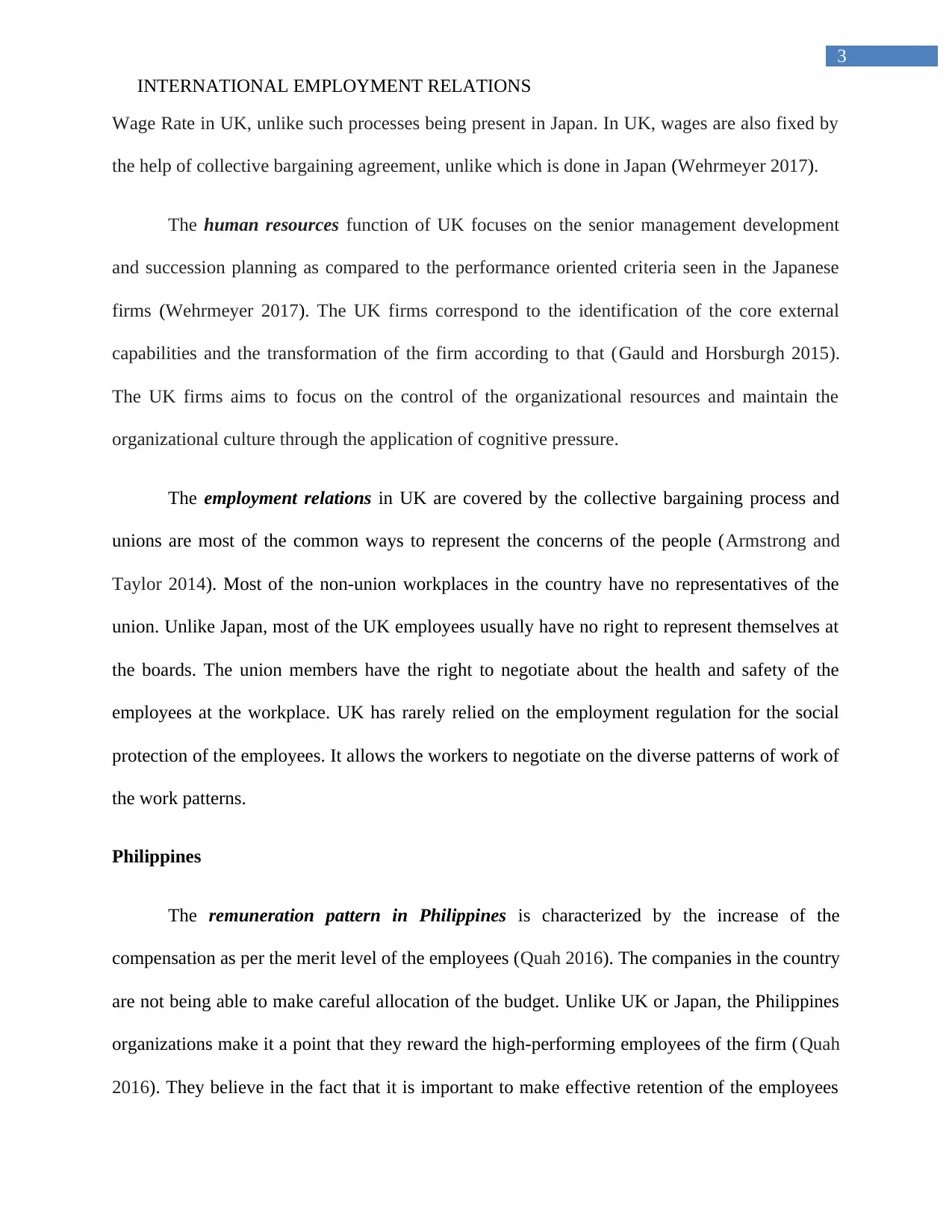
3
INTERNATIONAL EMPLOYMENT RELATIONS
Wage Rate in UK, unlike such processes being present in Japan. In UK, wages are also fixed by
the help of collective bargaining agreement, unlike which is done in Japan (Wehrmeyer 2017).
The human resources function of UK focuses on the senior management development
and succession planning as compared to the performance oriented criteria seen in the Japanese
firms (Wehrmeyer 2017). The UK firms correspond to the identification of the core external
capabilities and the transformation of the firm according to that (Gauld and Horsburgh 2015).
The UK firms aims to focus on the control of the organizational resources and maintain the
organizational culture through the application of cognitive pressure.
The employment relations in UK are covered by the collective bargaining process and
unions are most of the common ways to represent the concerns of the people (Armstrong and
Taylor 2014). Most of the non-union workplaces in the country have no representatives of the
union. Unlike Japan, most of the UK employees usually have no right to represent themselves at
the boards. The union members have the right to negotiate about the health and safety of the
employees at the workplace. UK has rarely relied on the employment regulation for the social
protection of the employees. It allows the workers to negotiate on the diverse patterns of work of
the work patterns.
Philippines
The remuneration pattern in Philippines is characterized by the increase of the
compensation as per the merit level of the employees (Quah 2016). The companies in the country
are not being able to make careful allocation of the budget. Unlike UK or Japan, the Philippines
organizations make it a point that they reward the high-performing employees of the firm (Quah
2016). They believe in the fact that it is important to make effective retention of the employees
INTERNATIONAL EMPLOYMENT RELATIONS
Wage Rate in UK, unlike such processes being present in Japan. In UK, wages are also fixed by
the help of collective bargaining agreement, unlike which is done in Japan (Wehrmeyer 2017).
The human resources function of UK focuses on the senior management development
and succession planning as compared to the performance oriented criteria seen in the Japanese
firms (Wehrmeyer 2017). The UK firms correspond to the identification of the core external
capabilities and the transformation of the firm according to that (Gauld and Horsburgh 2015).
The UK firms aims to focus on the control of the organizational resources and maintain the
organizational culture through the application of cognitive pressure.
The employment relations in UK are covered by the collective bargaining process and
unions are most of the common ways to represent the concerns of the people (Armstrong and
Taylor 2014). Most of the non-union workplaces in the country have no representatives of the
union. Unlike Japan, most of the UK employees usually have no right to represent themselves at
the boards. The union members have the right to negotiate about the health and safety of the
employees at the workplace. UK has rarely relied on the employment regulation for the social
protection of the employees. It allows the workers to negotiate on the diverse patterns of work of
the work patterns.
Philippines
The remuneration pattern in Philippines is characterized by the increase of the
compensation as per the merit level of the employees (Quah 2016). The companies in the country
are not being able to make careful allocation of the budget. Unlike UK or Japan, the Philippines
organizations make it a point that they reward the high-performing employees of the firm (Quah
2016). They believe in the fact that it is important to make effective retention of the employees
Paraphrase This Document
Need a fresh take? Get an instant paraphrase of this document with our AI Paraphraser
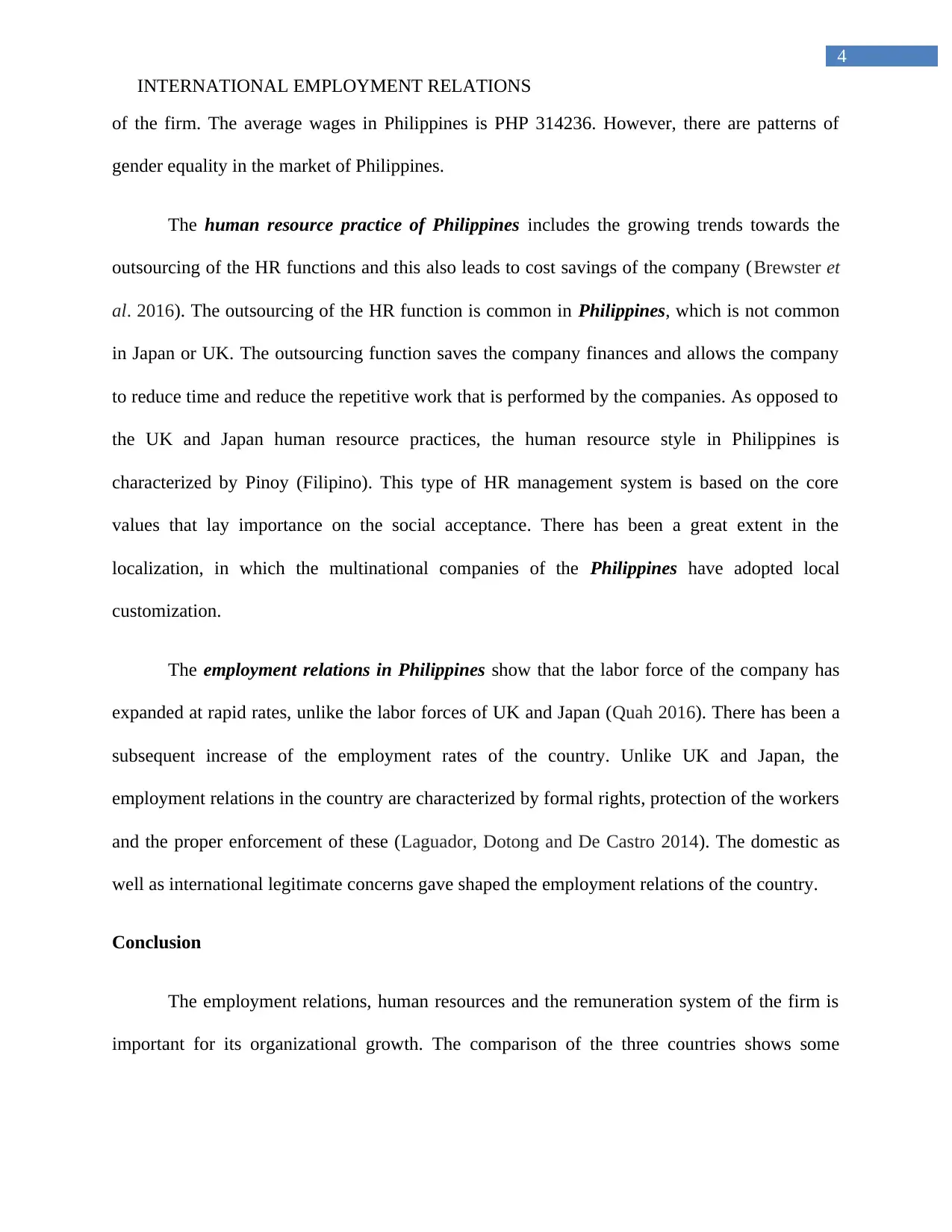
4
INTERNATIONAL EMPLOYMENT RELATIONS
of the firm. The average wages in Philippines is PHP 314236. However, there are patterns of
gender equality in the market of Philippines.
The human resource practice of Philippines includes the growing trends towards the
outsourcing of the HR functions and this also leads to cost savings of the company (Brewster et
al. 2016). The outsourcing of the HR function is common in Philippines, which is not common
in Japan or UK. The outsourcing function saves the company finances and allows the company
to reduce time and reduce the repetitive work that is performed by the companies. As opposed to
the UK and Japan human resource practices, the human resource style in Philippines is
characterized by Pinoy (Filipino). This type of HR management system is based on the core
values that lay importance on the social acceptance. There has been a great extent in the
localization, in which the multinational companies of the Philippines have adopted local
customization.
The employment relations in Philippines show that the labor force of the company has
expanded at rapid rates, unlike the labor forces of UK and Japan (Quah 2016). There has been a
subsequent increase of the employment rates of the country. Unlike UK and Japan, the
employment relations in the country are characterized by formal rights, protection of the workers
and the proper enforcement of these (Laguador, Dotong and De Castro 2014). The domestic as
well as international legitimate concerns gave shaped the employment relations of the country.
Conclusion
The employment relations, human resources and the remuneration system of the firm is
important for its organizational growth. The comparison of the three countries shows some
INTERNATIONAL EMPLOYMENT RELATIONS
of the firm. The average wages in Philippines is PHP 314236. However, there are patterns of
gender equality in the market of Philippines.
The human resource practice of Philippines includes the growing trends towards the
outsourcing of the HR functions and this also leads to cost savings of the company (Brewster et
al. 2016). The outsourcing of the HR function is common in Philippines, which is not common
in Japan or UK. The outsourcing function saves the company finances and allows the company
to reduce time and reduce the repetitive work that is performed by the companies. As opposed to
the UK and Japan human resource practices, the human resource style in Philippines is
characterized by Pinoy (Filipino). This type of HR management system is based on the core
values that lay importance on the social acceptance. There has been a great extent in the
localization, in which the multinational companies of the Philippines have adopted local
customization.
The employment relations in Philippines show that the labor force of the company has
expanded at rapid rates, unlike the labor forces of UK and Japan (Quah 2016). There has been a
subsequent increase of the employment rates of the country. Unlike UK and Japan, the
employment relations in the country are characterized by formal rights, protection of the workers
and the proper enforcement of these (Laguador, Dotong and De Castro 2014). The domestic as
well as international legitimate concerns gave shaped the employment relations of the country.
Conclusion
The employment relations, human resources and the remuneration system of the firm is
important for its organizational growth. The comparison of the three countries shows some

5
INTERNATIONAL EMPLOYMENT RELATIONS
striking similarities as well as differences. These three functions are one of the most important
practices of HR.
INTERNATIONAL EMPLOYMENT RELATIONS
striking similarities as well as differences. These three functions are one of the most important
practices of HR.
⊘ This is a preview!⊘
Do you want full access?
Subscribe today to unlock all pages.

Trusted by 1+ million students worldwide
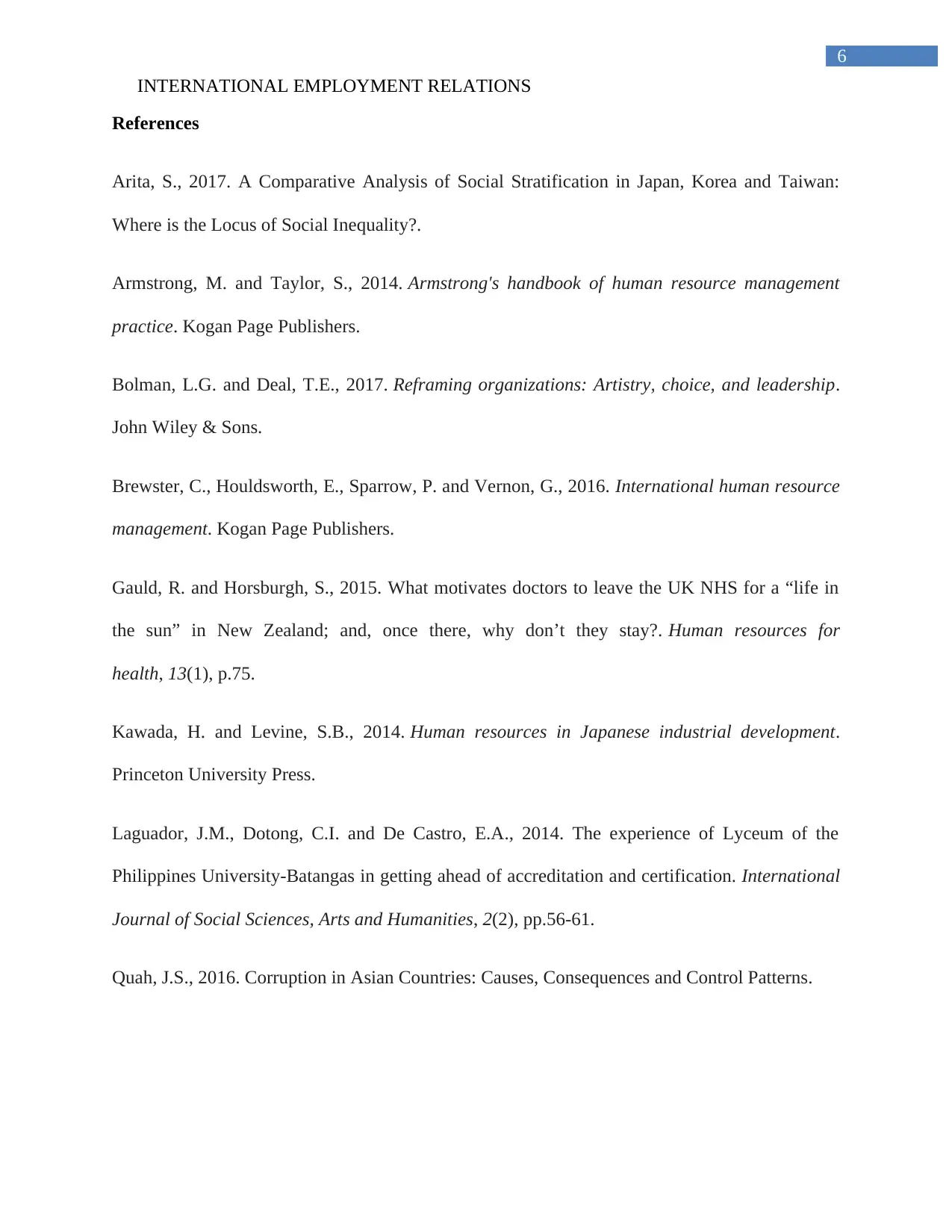
6
INTERNATIONAL EMPLOYMENT RELATIONS
References
Arita, S., 2017. A Comparative Analysis of Social Stratification in Japan, Korea and Taiwan:
Where is the Locus of Social Inequality?.
Armstrong, M. and Taylor, S., 2014. Armstrong's handbook of human resource management
practice. Kogan Page Publishers.
Bolman, L.G. and Deal, T.E., 2017. Reframing organizations: Artistry, choice, and leadership.
John Wiley & Sons.
Brewster, C., Houldsworth, E., Sparrow, P. and Vernon, G., 2016. International human resource
management. Kogan Page Publishers.
Gauld, R. and Horsburgh, S., 2015. What motivates doctors to leave the UK NHS for a “life in
the sun” in New Zealand; and, once there, why don’t they stay?. Human resources for
health, 13(1), p.75.
Kawada, H. and Levine, S.B., 2014. Human resources in Japanese industrial development.
Princeton University Press.
Laguador, J.M., Dotong, C.I. and De Castro, E.A., 2014. The experience of Lyceum of the
Philippines University-Batangas in getting ahead of accreditation and certification. International
Journal of Social Sciences, Arts and Humanities, 2(2), pp.56-61.
Quah, J.S., 2016. Corruption in Asian Countries: Causes, Consequences and Control Patterns.
INTERNATIONAL EMPLOYMENT RELATIONS
References
Arita, S., 2017. A Comparative Analysis of Social Stratification in Japan, Korea and Taiwan:
Where is the Locus of Social Inequality?.
Armstrong, M. and Taylor, S., 2014. Armstrong's handbook of human resource management
practice. Kogan Page Publishers.
Bolman, L.G. and Deal, T.E., 2017. Reframing organizations: Artistry, choice, and leadership.
John Wiley & Sons.
Brewster, C., Houldsworth, E., Sparrow, P. and Vernon, G., 2016. International human resource
management. Kogan Page Publishers.
Gauld, R. and Horsburgh, S., 2015. What motivates doctors to leave the UK NHS for a “life in
the sun” in New Zealand; and, once there, why don’t they stay?. Human resources for
health, 13(1), p.75.
Kawada, H. and Levine, S.B., 2014. Human resources in Japanese industrial development.
Princeton University Press.
Laguador, J.M., Dotong, C.I. and De Castro, E.A., 2014. The experience of Lyceum of the
Philippines University-Batangas in getting ahead of accreditation and certification. International
Journal of Social Sciences, Arts and Humanities, 2(2), pp.56-61.
Quah, J.S., 2016. Corruption in Asian Countries: Causes, Consequences and Control Patterns.
Paraphrase This Document
Need a fresh take? Get an instant paraphrase of this document with our AI Paraphraser
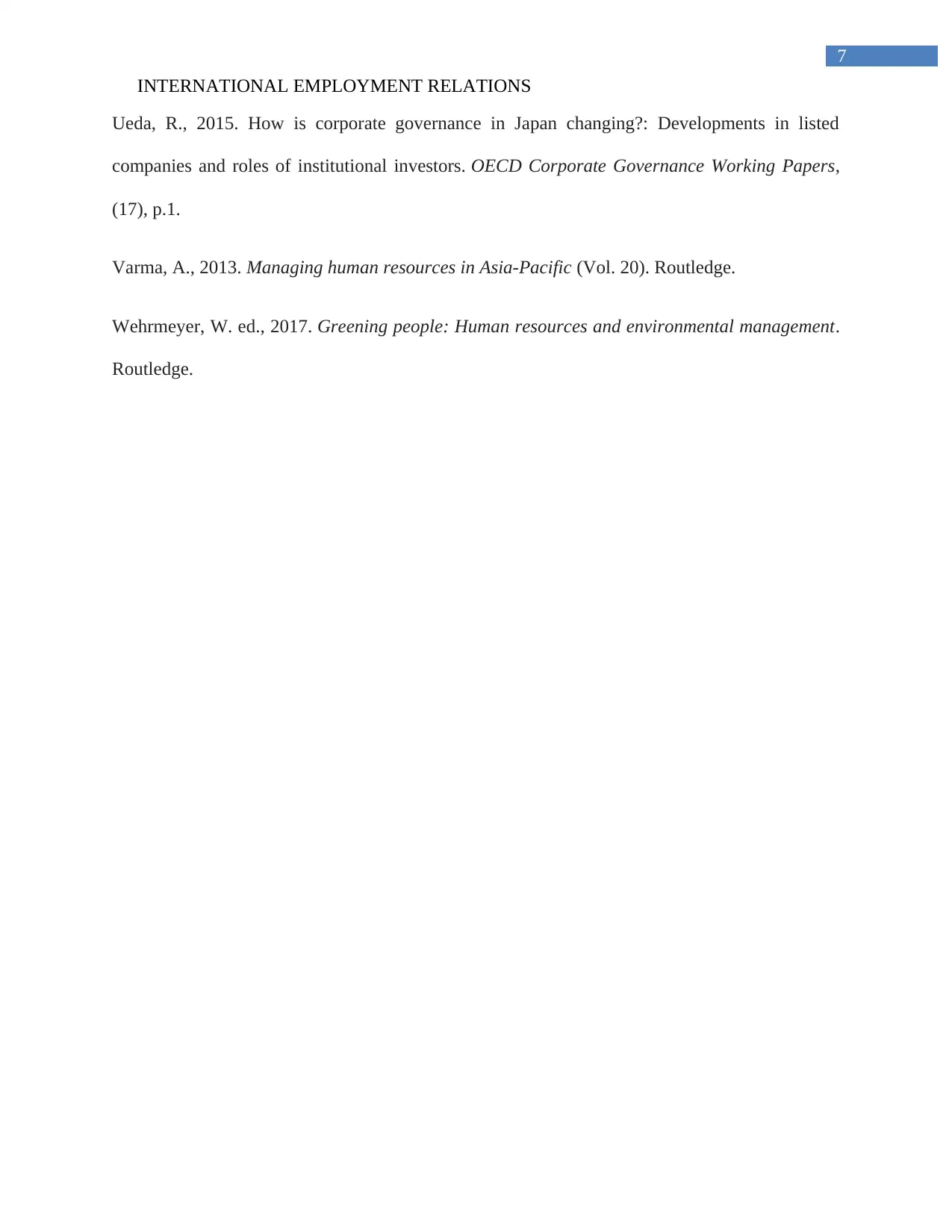
7
INTERNATIONAL EMPLOYMENT RELATIONS
Ueda, R., 2015. How is corporate governance in Japan changing?: Developments in listed
companies and roles of institutional investors. OECD Corporate Governance Working Papers,
(17), p.1.
Varma, A., 2013. Managing human resources in Asia-Pacific (Vol. 20). Routledge.
Wehrmeyer, W. ed., 2017. Greening people: Human resources and environmental management.
Routledge.
INTERNATIONAL EMPLOYMENT RELATIONS
Ueda, R., 2015. How is corporate governance in Japan changing?: Developments in listed
companies and roles of institutional investors. OECD Corporate Governance Working Papers,
(17), p.1.
Varma, A., 2013. Managing human resources in Asia-Pacific (Vol. 20). Routledge.
Wehrmeyer, W. ed., 2017. Greening people: Human resources and environmental management.
Routledge.
1 out of 8
Related Documents
Your All-in-One AI-Powered Toolkit for Academic Success.
+13062052269
info@desklib.com
Available 24*7 on WhatsApp / Email
![[object Object]](/_next/static/media/star-bottom.7253800d.svg)
Unlock your academic potential
Copyright © 2020–2025 A2Z Services. All Rights Reserved. Developed and managed by ZUCOL.





